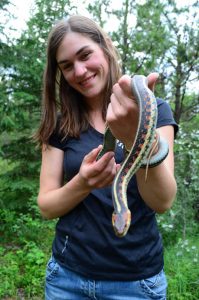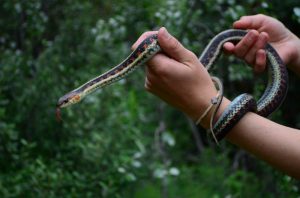Woman surprised by giant garter
by EVAN MATTHEWS

Beth Russell was forced to face a lifelong fear this week; a snake wrapped around two of her potato stalks was the largest she had ever seen.
Her fear of snakes, known as ophidiophobia, has been with her all her life, Russell says. Naturally, she was grateful for her friend who grabbed a ski pole and moved the reptile to a nearby pail in the shade, which was covered, but with a hole left on top for the snake to breathe.
“I was nervous because it was such a big snake,” says Russell. “I had not seen a snake this size on any of my nature walks, ever.”
The snake, which was a common garter, measured one metre, Russell says.
She called a friend named Jill McAllister, who is a University of Victoria Masters student. McAllister has been monitoring reptile and amphibian populations in the Kinbasket Reservoir.
McAllister collected the snake from Russell. She named her Amber for her beautifully coloured head.
“Amber is the biggest garter snake I’ve ever seen,” says McAllister. “She’s about 330 grams. She’s quite impressive.”
McAllister is studying why some wetlands in the north have garter snakes and other wetlands don’t, when both contain smaller amphibians that make up their diet.
She posits that the difference is a lack of suitable hibernation spots causing patchy distribution of garter snakes in the north.
At this point, not much is known about snake hibernation in the area, she says, and McAllister is rounding up as many large, female garter snakes to try and change that.
“We’re doing a simple procedure with the vet,” says McAllister.
“We’re putting in a radio telemetry transmitter, which is less than five per cent of their body weight, and it goes within their body cavity with a little antenna running underneath their skin,” she says.

With her receiver, McAllister says she can go find the snakes and identify what type of habitat they’re using, their daily average movement, and — to understand the timing and patterns — she follows them to their hibernation sites.
McAllister has implanted a radio transmitter into Amber and wonders if she will end up at Cranberry Marsh. The marsh used to be a lake, which flowed toward the Russell’s property, and there are a bunch of little wetlands near the Russell’s.
“It would be really interesting to see if she returns to the marsh, or if they have other hibernating spots,” she says.
The plan is to remove the transmitter next spring, after hibernation patterns have been observed, McAllister says. Post operation care includes antibiotics and medication for pain, and 24-hour observation, which Russell says made her happy to know.



